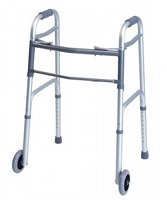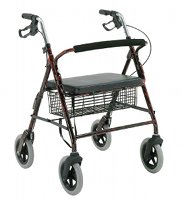Selecting a Walker
https://www.youtube.com/watch?v=KfDkmIv1aTk
Selecting a Front Wheel Walker (Also called: Two Wheel or 2WW)


Front wheel or two wheel walkers for elderly are much like standard walkers but with wheels on the front and often have skids/skis on the rear legs. This allows it to more easily slide on the ground.
Similar to a folding walker, they can usually fold in half to store in the trunk of a car, etc.
Who Should Use a Front Wheel Walker?
Elderly who need to place some weight onto the walker (but not all). It is also light weight, easy to transport and slides across the floor. Some people who have rollator walkers for elderly also have front wheel walkers to take with them when they travel as they are foldable, lightweight and can more easily fit in the trunk of a car.
Who Should NOT Use a Front Wheel Walker?
Elderly who need to place most of their weight on the walker – for example, if the doctor does not want them to place any weight on an injured foot/leg or post hip surgery. Although they are lighter than rollator walkers for elderly, they do not work well outside.
How to Use a Front Wheel Walker
- Adjust to proper height – See below for how to fit walker.
- Get in position – Place both hands on the handles.
- Stand upright – This will likely place the users toes/midfoot in line with the rear legs.
- Advance walker – Push the walker in front of you so that you are walking within the walker.
- Walk into the walker – If the senior has a sore leg/foot or a leg that the doctor does not want them to put full weight through, then advance this leg first followed quickly by the other.
- Small steps – Take small steps especially while turning around – for example to get into a chair.
- No lifting needed – The advantage of these types of walkers for elderly over standard walkers is that the senior does not need to pick it up to walk.
Recommended Features
- Large fixed – Larger wheels roll better over uneven ground. Some front wheel walkers for elderly have swivelling wheels (like a shopping cart) but they are not as stable as the fixed wheels.
- Lightweight – Light enough so the user can easily manoeuvre it as well as pick it up to place in car trunk, etc. That being said, if the user is a rather large individual, they will need to make sure it is strong enough to carry their weight.
- Sturdy – Make sure the walker legs are sturdy and even. Some poorly made walkers have legs that are not exactly even so that it rocks. This makes it difficult to use and is a safety risk.
- Foldable – Make sure it can fold in half so that it is easy to take in the trunk of a car, etc.
Accessories
- Skis/Skids/Tennis Balls – These allow the rear legs to slide more easily on the ground than the regular rubber tips.
- Oxygen tank holders – This can be difficult to manage as it increases the weight of the walker making it more difficult to move.
- Trays/Bags – The bags are more useful than the trays as items can easily fall off the tray and are more likely to stay in the bag. These can be excellent additions to a folding walker as both hands are in use while using the walker (ie. no free hand to carry items around house).
- Foam handles – They make walkers for elderly more comfortable – especially for those with arthritis – as the user will be placing a fair amount of weight onto the handles while using it.
Selecting a Rollator Walker (Also called: 4 Wheel or 4WW)


Rollators (also called 4 wheel walkers) are just that – walkers for elderly with four wheels, brakes, a seat and a basket/bag. They work well both indoors and outdoors – especially models with large wheels that easily roll over uneven ground and carpet.
Who Should Use a Rollator?
Elderly who need a walker for balance but do not need to put much weight onto it. It is also beneficial for seniors who need a seat to rest, want to carry items and want the security of having something to hold onto when walking. Most versions are also foldable and can fit in the trunk of a car. The styles with larger wheels are recommended as they roll easier on uneven ground and are usually more stable.
Who Should NOT Use A Rollator?
Elderly who have a sore foot/leg/hip and the doctor does not want them to place weight onto it (ex. post hip surgery). This is usually temporary and the senior can progress to a rollator at a later date.
Elderly with significant balance, strength and endurance issues. They may be safer using a two wheel walker or wheelchair – depending on what is causing their difficulty walking.
How to Use a Rollator
- Adjust to proper height – see below for how to fit a walker
- Lock brakes – I recommend locking the brakes anytime elderly are sitting down on the walker’s seat or getting up/down from a chair/bed/couch with the walker in front of them. On most rollator walkers with seats, the senior can lock the brakes by pressing the brake levers down till they lock in place. This ensures the walker will not roll away from the user.
- Get in position – Place both hands on the handles.
- Stand upright – This will likely place the users toes/midfoot in line with the rear wheels
- Walk normally – Try to stay in a normal upright walking position and not to hunch over or get the walker to far ahead.
- Small steps – Take small steps especially while turning around – for example to turn around to get into a chair.
- Using seat – Find level ground, lock brakes, turn around and sit down. Do not sit down to hard as brakes are built for light hold only.
Recommended Features
- Large wheels – Larger wheels roll over uneven ground easier which makes it more enjoyable to use outside and also safer.
- Lightweight – Some walkers are too heavy for smaller seniors as they cannot push them around easily – putting them at risk of falling.
- Easy to use brakes – Some brakes are too stiff for elderly so be sure to have the senior try the brakes – both squeezing them as well as locking them.
- Padded seat – Elderly will use the seat if it is comfortable.
- Basket/Bag – I prefer models that allow easy access to the basket/bag while in the normal walking position. Baskets that are only accessible by reaching over top or around the walker are not safe and inconvenient.
Accessories
- Standard options – Most walkers come with several standard features such as a basket/bag and padded seat.
- Oxygen tank holders – Some walkers have enough room in the basket/bag for an oxygen tank or small portable concentrator. Others will benefit from an oxygen tank holder. Make sure it keeps the weight low to the ground or it makes the walker top heavy and prone to tipping over – Especially on uneven ground outside (such as a curb cutout at a crosswalk).
- Cane holder – To hold their cane securely.


